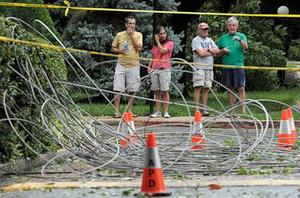Emergency responseNew York overhauls emergency response capabilities post-Irene
Last week New York Governor Andrew Cuomo proposed a series of major initiatives to bolster the state’s emergency response capabilities; the proposals specifically incorporate lessons learned from the state’s response to Hurricane Irene and Tropical Storm Lee

Downed power lines were only part of the difficulty in responding to Irene // Source: banglabazar.co.in
Last week New York Governor Andrew Cuomo proposed a series of major initiatives to bolster the state’s emergency response capabilities.
The proposals specifically incorporate lessons learned from the state’s response to Hurricane Irene and Tropical Storm Lee.
“We learned from Hurricane Irene and Tropical Storm Lee that we must be ready and have the capabilities to respond to all emergencies. Our state’s first responders are second to none, but they need a highly coordinated network to support them,” Cuomo said. “Today we are launching a series of new actions to ensure that our first responders are properly equipped to respond quickly and effectively in an emergency anywhere and anytime.”
To that end, Cuomo has proposedcreating five Regional Disaster Logistics Centers that will stockpile necessary equipment and serve as staging areas for multiple state and local agencies and the National Guard. These staging grounds will help ensure that critical equipment and resources are in place before an emergency hits.
Other proposed changes include the creation of a state emergency database to coordinate disaster response equipment and personnel as well as the creation of ten Rapid Response Support Teams that will be deployed in emergencies to coordinate state efforts with local governments. The teams will include representatives from the State Office of Emergency Management, State Police, National Guard, and other agencies.
In addition the governor has ordered the state to review all of its equipment and sell any excess, unnecessary, or outdated emergency response gear.
The planned changes stem from the state’s review of emergency response capabilities following Hurricane Irene and Tropical Storm Lee. The review found that the state’s first responders acted competently and executed their jobs well, but that there were still shortcomings in New York’s coordination and preparation. More specifically, there were problems aligning resources to need, a lack of equipment pre-deployed to regions in the storms’ paths, and aging equipment.
“One of my first priorities was to assess the State’s disaster asset inventory,” said Jerome Hauer, the head of the review and the Commissioner of New York’s Division of Homeland Security and Emergency Services. “We found that much of the equipment was inadequate to support an effective disaster response. By establishing these Disaster Preparedness Centers, we are ensuring that State and local responders have the right tools to respond to emergencies more rapidly and effectively. Governor Cuomo tasked me to create the best emergency operations system in the country, and this major overhaul has the potential to make New York State a national leader in disaster response capabilities.”
